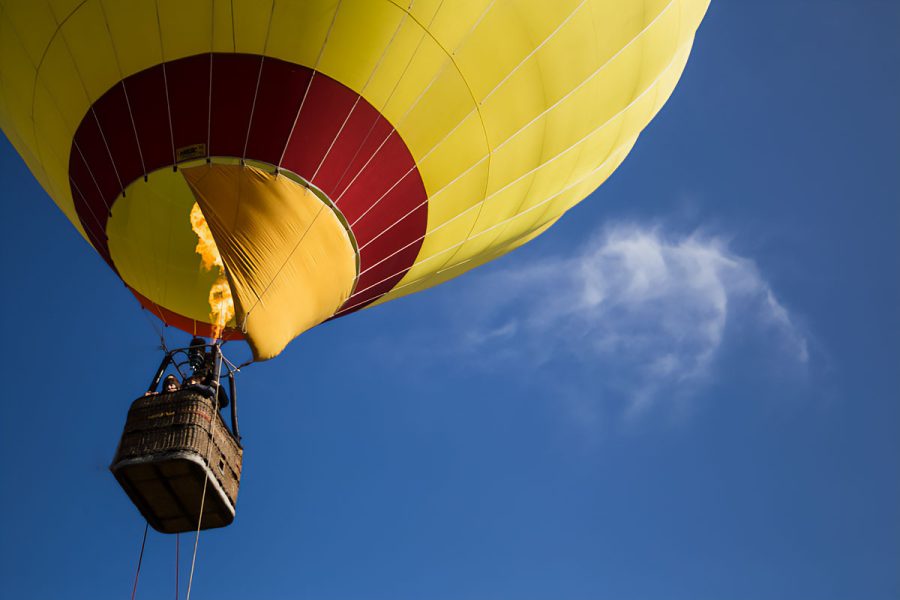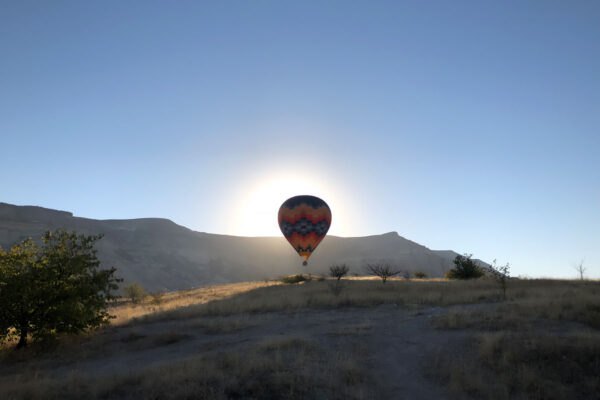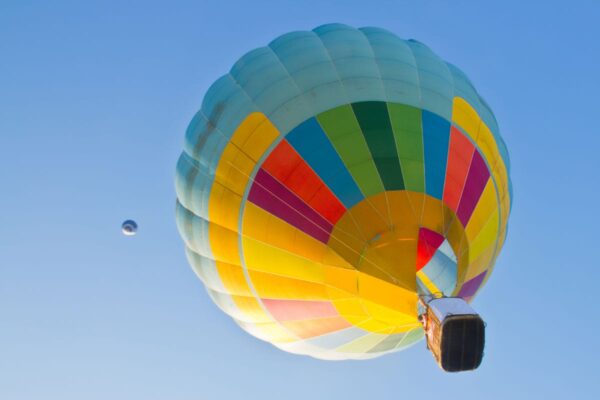A balloon flight is an extraordinary experience. Hovering above the ground in the basket of the balloon gives you a sense of freedom. The view from above is stunning. Every flight requires observance of safety rules. Knowing them ensures comfort and safety for all participants.
Before your first balloon flight, it is a good idea to learn the basic procedures. It is important to be properly prepared and to know the rules for takeoff and landing. The passenger should know his rights and responsibilities.
The pilot always conducts a pre-flight briefing. During it, he communicates key safety information. Listening to the pilot’s instructions is essential for a successful flight.
Weather has a significant impact on balloon flight. Flights are conducted only in favorable weather conditions. The absence of strong winds and good visibility are basic requirements.
Proper attire and equipment add to the comfort. It is worth taking a camera to capture the views. A balloon flight is an adventure that remains in the memory for a long time.
Flight preparation and passenger briefing
A balloon flight requires careful preparation. Every passenger should be familiar with the procedures before takeoff. Check-in is a key element to ensure a safe flight.
Pre-flight briefing process
The day before the flight, passengers receive an SMS or email with information about the planned flight. The weather has a decisive impact on its execution. In case of unfavorable conditions, the flight is postponed.
On the day of the flight, you must appear at the designated place. This is usually 60-120 minutes before sunrise. Punctuality is important. Lateness can result in exclusion from the flight.
When participants arrive, the pilot conducts a detailed briefing. He discusses the flight, rules of conduct and emergency procedures. Those unfamiliar with the language may receive briefing materials in a different format.
It is advisable to use the restroom before departing for the launch site. During the flight and for the next 2-3 hours there will be no such opportunity. Physical comfort affects the overall flight experience.
The group is transported to the launch site. The location depends on the wind direction and weather conditions. The final decision on the launch site is made by the pilot.
Preparation of the balloon for flight
The process of preparing the balloon takes about 25-30 minutes. Passengers can observe all stages, and perform some activities under the supervision of the crew.
First, the balloon basket is pulled from the trailer, and a burner is mounted on top of it. After checking its operation, the balloon canopy is attached to the basket, which is then unfolded on the ground.
Filling the balloon canopy begins with cold air, forced in by large fans. When the canopy is partially filled, the pilot heats the air with a burner.
- Checking the onboard instruments
- Checking the gas cylinders
- Spreading the canopy on the ground
- Filling the canopy with cold air
- Heating the air with a burner
When the balloon rises vertically, passengers can enter the basket. Entrance is made by putting a leg over the side with a height of about 120 cm. Those with difficulties can use a special step.
Tip: It is worth taking photos of the process of filling the balloon. The view of the huge, colorful canopy filling with air is impressive. The best shots can be obtained by standing at a safe distance, but in a place that allows you to take in the entire balloon canopy.
Safety instructions
Safety instruction is a mandatory part of any flight. The pilot provides the most important information on rules of behavior and emergency procedures.
During the briefing, the following are discussed:
- The course of the flight
- Position during inflation of the balloon
- Location of emergency equipment
- Smoking and alcohol rules
- Burner precautions
- Landing procedures
Understanding the landing position is particularly important. Passengers practice correct posture even before takeoff to avoid confusion in an emergency. Position includes bent knees, joined feet and a firm grip on the basket handles.
Passengers should wear appropriate clothing and footwear. Loose items of clothing can be a hazard. Smoking and alcohol consumption before and during the flight is prohibited.
Each balloon is equipped with emergency equipment such as a fire extinguisher, first aid kit and communication devices. The pilot indicates their location during the briefing.
People with health problems should inform the pilot before the flight. Participation of persons under the influence of alcohol or drugs is not allowed for safety reasons.
Behavior during takeoff and landing of the balloon
Takeoff and landing are key moments of the flight. Proper behavior during these phases ensures the safety of all participants. Knowing the procedures helps reduce stress and enjoy the flight.
Balloon launch procedure
Preparing for takeoff takes between 20 and 40 minutes. The process consists of several stages that can be observed from a safe distance. Passengers can assist in some activities under the supervision of the crew.
First, the basket is unfolded and the burner is mounted on four nylon supports. The burner is then connected to the basket with carabiners. The crew connects the gas hoses to the propane tanks located in the basket.
After checking the burner, the balloon canopy is taken out of the carrying bag and attached to the basket. When it lies unfolded on the ground, the filling process begins.
Two crew members hold the lower part of the canopy open while a fan injects cold air. At the same time, another crew member secures the parachute valve on top of the balloon and tightens the crown rope.
The pilot starts the burner, heating the air inside the canopy. The balloon slowly rises and assumes an upright position. Only then can the passengers enter the basket.
Tip: When inflating the balloon, stay away from the fans. They can pull in loose pieces of clothing, hair or camera straps. Tension ropes can be under a lot of tension, so use caution.
Safety rules for flight
Balloon flight is a peaceful experience. Hovering in the air gives a unique sense of freedom. However, even during such an activity, safety rules apply.
Passengers should stand in designated places in the basket. Rapid movements can make it difficult for the pilot to steer. Do not lean overboard or throw objects.
The balloon burner produces a flame that reaches up to 6 meters. Keep a safe distance from the burner and wires. Smoking is prohibited due to the presence of propane cylinders.
The pilot controls the flight altitude by heating the air inside the canopy. Warm air causes ascent, and cooling or releasing it through the valve causes descent.
The direction of flight depends on the wind. There may be different air currents at different altitudes. The pilot uses these differences to navigate, but the landing site is not fully predictable.
Safe landing technique
Landing is often the most exciting part of a flight. The pilot informs the pilot of his approach and reminds him to assume the correct position.
A few minutes before landing, a suitable place for touchdown is selected. It should be open and free of obstacles such as power lines or tall trees. The pilot lowers the balloon to an altitude of about 150 meters to assess the terrain.
Just before landing, passengers must assume a safety position:
- Crouch down, keeping knees together.
- Bend their legs slightly, preparing to cushion the landing.
- Firmly grasp the ropes inside the basket (not the control rope, props or fuel lines).
- Keep hands and arms inside the basket.
The pilot pulls on the rope connected to the parachute valve, releasing the hot air. The basket touches the ground. It may be pulled by the wind before it comes to a complete stop. This is a normal occurrence.
Once the basket has stopped, stay inside and wait for the pilot’s instructions. Leaving too soon may cause the balloon to rise again or the basket to tip over.
The landing may be gentle, but sometimes the basket tilts or slides on the ground. This method of landing has been used for more than 200 years and is not dangerous.
Health and age restrictions for passengers
A hot air balloon flight is a unique experience available to many people. However, there are certain health and age restrictions that should be known before booking. Safety is a priority, which is why balloon companies use specific criteria for passenger eligibility.
Age restrictions
Children can take flights, but age and height limits apply. The minimum age is usually 7-8 years old. Younger children may have difficulty understanding safety instructions and behaving properly during the flight.
In addition to age, the passenger’s height is important. The minimum height is usually 120-140 cm (about 4’6″). The balloon basket is about 110 cm (42″) high, so shorter people may not be able to see the views over the edge of the basket.
Children under the age of 16 must be accompanied by an adult. There should be a maximum of two children per adult, which ensures proper care in case of emergencies.
There is no strict upper age limit. Seniors can participate in a flight if they meet the physical fitness requirements. Maintaining a standing position throughout the flight and being able to enter and exit the basket independently are key.
Tip: For children, it is advisable to choose a shorter flight (30-45 minutes instead of 60-90 minutes). A shorter time in the air will ensure a memorable experience without the risk of fatigue or boredom.
Health contraindications
Some medical conditions may prevent a safe balloon flight. Knowing the contraindications allows you to avoid unpleasant situations and health risks.
Pregnancy is an absolute contraindication to flight. Pressure changes and the possibility of a hard landing can be dangerous for both mother and child.
Cardiovascular diseases can pose a risk. The ascent and descent of the balloon causes pressure changes, which puts a strain on the cardiovascular system. People after a heart attack, with heart disease or high blood pressure should consult a doctor about flying.
Asthma and other respiratory conditions require special attention. For every 8 meters of altitude, atmospheric pressure drops by 1 hPa, which can affect the respiratory system. People with asthma should carry bronchodilator medication with them.
Recent surgeries or fractures preclude participation in the flight. The body needs time to recover, and landing can be dynamic. It is advisable to wait at least six months after major surgery.
Problems with the knee, hip or spine joints can make it difficult to assume a safety position during landing. Passengers must be able to bend their knees and cushion any impact of the basket on the ground.
Physical fitness requirements
Balloon flight is not an extreme activity, but it does require basic physical fitness.
Each passenger must enter the basket independently. The ascent is similar to climbing a short ladder. Use the openings in the side of the basket and put your leg over the edge. People with limited mobility may have difficulty.
During the flight, passengers must stand for the entire duration. The standard flight length ranges from 45 to 90 minutes, and the basket is not equipped with seats.
During landing, passengers assume a special safety position:
- Feet together, knees slightly bent.
- Back resting against the cushioned wall of the basket.
- A firm grip on the inner handles.
Persons under the influence of alcohol or drugs are not allowed to take part in the flight. These substances impair judgment and motor coordination, which can lead to dangerous situations. It is recommended to refrain from alcohol consumption at least 12 hours before the flight.
The maximum allowable weight of a passenger is usually 114-140 kg. This limitation is due to the design of the basket and the capabilities of the balloon. Balloon companies may ask for weight at the time of booking in order to plan passenger placement accordingly.
Etiquette in the balloon basket and communication with the pilot
Proper behavior in the balloon basket and effective communication with the pilot are critical to the safety and comfort of all participants in the flight. Adhering to the rules of balloon etiquette ensures that this unique adventure runs smoothly.
Rules of behavior in the balloon basket
A balloon basket is a small space that holds between 6 and 16 people. Mutual respect and adherence to certain rules are essential for the comfort of all passengers.
During the flight, each passenger should remain in the designated area. Moving around the basket can upset the balloon’s balance and make it difficult for the pilot to steer. The seats in the basket are carefully arranged to ensure even weight distribution.
Leaning over the side of the basket is prohibited. Such behavior increases the risk of falling out and can disrupt the stability of the balloon. Hands and other body parts should always remain inside the basket.
Noise in the basket should be moderate. Loud conversations can interfere with other passengers’ enjoyment of the view and enjoyment of the flight. Calmness allows you to fully experience the unique atmosphere of floating in the air.
Taking pictures is allowed, but care should be taken not to disturb other passengers. Everyone should be able to enjoy the scenery and take pictures. If several people want to capture the same view, it is advisable to wait for your turn.
Tip: Before using the flash, it’s a good idea to warn the other passengers. A sudden flash can be unpleasant, especially if your eyesight is accustomed to natural lighting.
Communication with the pilot and crew
The balloon pilot is responsible for the safety of all passengers. His instructions have top priority and must be obeyed without fail.
The pre-flight safety briefing contains key information. Listen carefully and ask questions if something is unclear. Knowledge of safety procedures affects comfort and confidence during the flight.
During the flight, avoid distracting the pilot with unnecessary questions. His attention is focused on controlling the balloon, observing weather conditions and communicating with the ground crew. If safety concerns arise, they should be raised.
Communication with the pilot should be clear and concise. In emergency situations, quick and precise communication is key. Sometimes the pilot may ask passengers to help prepare the balloon for flight or assemble equipment after landing.
The ground crew follows the balloon in cars and maintains constant radio contact with the pilot. Coordination between the pilot and ground crew ensures a smooth flight and safe landing.
Safety rules during the flight
Safety during a balloon flight depends on following a few basic rules. Knowing these rules allows you to avoid hazards and enjoy the adventure without stress.
Never wrap ropes around any part of the body. The ropes can be under a lot of tension and cause injury if jerked suddenly. Also, do not allow your feet to come off the ground while holding the balloon.
Smoking is prohibited in and around the balloon basket. Balloons are filled with flammable propane, so even a small spark can lead to a fire. The ban also applies to e-cigarettes and other heat-emitting devices.
During the flight, it is worth paying attention to the pilot’s comments on passing objects. The pilot often points out places of interest and tells about the landscape visible from above. A balloon flight is not only a unique experience, but also an opportunity to get to know the area from a new perspective.
Balloon equipment such as control cables, props or fuel lines should not be touched by passengers. Accidentally pulling a rope or tampering with a cable can affect the safety of the flight. If in doubt, always ask the pilot.
Loose items such as scarves, jewelry or camera straps should be well secured. They can be pulled in by the fans used to fill the balloon or become entangled in onboard equipment. Long hair should also be tied up.
Items allowed and forbidden during the flight
Before your first balloon flight, it’s a good idea to think carefully about what to take into the basket. Space is limited, and some items can be hazardous. Knowing the list of allowed and forbidden items allows you to avoid problems and enjoy the flight without complications.
What to take aboard a balloon
Several basic items are useful during a balloon flight. The list is not long, but each item has a practical use.
A camera or smartphone with a good camera is a must. The views from above are unique and worth capturing. Small compact cameras work better than large SLR cameras, as space in the basket is limited. Equipment should be secured with a wrist or neck strap.
Sunglasses protect your eyes from intense light, especially when flying at sunrise. At high altitudes, the sun’s rays are stronger because nothing blocks them.
Headgear, such as a baseball cap, protects against the sun. A light hat will work well on morning flights, when the sun begins to heat up more strongly. Be sure to keep the hat securely on your head so that it is not blown away by the wind.
A small bottle of water helps keep you hydrated. On warm days, adequate hydration is especially important. The bottle should have a cap to avoid spills in the trash.
Tip: It’s a good idea to use the restroom before your flight. There are no sanitary facilities in the basket, and the flight, including the entire ceremony, can take several hours. Physical comfort affects the enjoyment of the flight.
Items prohibited in the balloon basket
Some items are categorically prohibited during the flight. Their presence can pose a threat to passenger safety.
Food and drinks (except for a small bottle of water) are usually not allowed. Spilled liquids can damage balloon equipment, and crumbs attract insects. Eating food can also be distracting and take your attention away from exceptional views.
Selfie sticks are often prohibited unless the flight is in private mode. Long objects can get in the way of other passengers or become entangled in the balloon’s ropes and equipment.
Flammable substances, such as lighters, aerosols or perfume sprays, pose a serious hazard. The proximity of an open flame makes the risk of ignition high. Even a small spark can lead to a fire.
Loose items such as jewelry, scarves or belts should be secured. They can be pulled in by the fans used to fill the balloon or become entangled in equipment. Long hair is also worth tying up.
Heavy camera equipment requires prior consultation with the flight organizer. Large cameras may be inconvenient to use in the confined space of the basket. For professional equipment, this should be noted at the time of booking.
Proper attire for a balloon flight
Proper attire is crucial for comfort and safety. A few simple rules will help you properly prepare for this unique adventure.
Clothing made of natural fibers is recommended. Materials such as cotton or linen will smolder when in contact with fire, instead of melting like synthetics. Molten fabrics can stick to the skin, causing serious burns.
Outfits should be layered and tailored to the season. Temperatures at altitude may differ from those on the ground. Contrary to popular belief, it is often warmer in the basket of a balloon than on the ground because the heat from the burner warms the passengers.
Footwear must be flat, comfortable and covered. Athletic shoes with non-slip soles work best. Sandals, flip-flops or high-heeled shoes are inappropriate. Landing may take place on uneven terrain, where stable footwear is essential.
Pants are more practical than dresses or skirts, especially for getting in and out of the basket. A high side requires a leg lift, which can be uncomfortable in some clothing.
Protective gloves are recommended for the pilot, but passengers can also bring them. They protect the hands from abrasion from the ropes and the side of the basket. The pilot always wears flame-resistant gloves to protect against burns when operating a torch.
Safe behavior during the flight and after landing
Balloon flight is a unique experience that requires adherence to safety rules. Proper behavior during the flight and after landing is critical to the comfort and safety of all participants. Knowing the procedures allows you to enjoy this extraordinary adventure without undue stress.
Behavior during the flight
It is important to remain alert and calm during the balloon flight. A stable position in the basket is crucial for safety. Rapid movements can upset the balloon’s balance and make steering difficult. Feet should be shoulder-width apart for better stability.
The balloon basket is usually about 106 cm (42 inches) high. Passengers must be tall enough to see over the edge of the basket. Leaning over the side is forbidden, as there is a risk of falling out.
Do not touch fuel lines or ropes in the pilot’s compartment during flight. Accidentally pulling the control rope may unintentionally release hot air from the balloon canopy.
The balloon burner produces a very hot flame. The burner is operated only by the pilot, who usually uses protective gloves. Passengers should stay away from the burner and its components.
Note: The temperature in the balloon basket can be 10-15 degrees higher than the ambient temperature. The heat from the burner warms passengers, so even on colder days it can be warm. Layered clothing allows you to adapt to changing conditions.
Landing procedure
Landing is one of the most important moments of a flight. The pilot informs passengers of its approach and reminds them to assume the correct position. Proper preparation minimizes the risk of injury.
Before landing, stow away all loose items such as phones, cameras or glasses. These can be damaged or cause injury when the basket makes contact with the ground.
The correct landing position includes:
- Crouching with knees joined together.
- Slight bending of the legs, ready to cushion the landing.
- Holding firmly to the rope inside the basket (not the control rope, props or fuel lines).
- Keeping all parts of the body inside the basket.
Landing a balloon may involve tilting the basket, bouncing or pulling on the ground. Such phenomena have been occurring in balloon flights for more than 200 years and pose no danger. The basket and landing position are designed to ensure safety.
Even after contact with the ground, the basket may be dragged by the wind for a while. In such a situation, it is necessary to maintain the landing position and hold on tightly to the handles. Leaving the basket too soon may cause the balloon to rise again.
After landing
After landing, passengers should remain in the basket and wait for the pilot’s instructions. Only the pilot can decide when it is safe to leave the basket. Exiting too quickly can disrupt the stability of the balloon.
Losing the weight of a passenger can cause the balloon to rise again, posing a danger to other people. If the basket is still moving, lowering it may result in the passenger tipping over.
Use caution after being allowed to exit the basket. The landing area may be uneven, muddy or wet. Proper footwear makes it easier to navigate such ground.
The process of assembling the balloon is an interesting part of the flight, and passengers can often participate. The pilot coordinates the activities of deflating the canopy and packing the equipment. Passenger assistance is welcome, but should be under the supervision of the pilot.
After the flight, the ground crew often holds a champagne ceremony. This is an opportunity to celebrate a successful flight and exchange impressions with other participants.
The entire balloon flight experience, from preparation to completion of the ceremony, can take several hours. It is worth reserving enough time to fully enjoy all elements of this extraordinary adventure.
Summary
A hot air balloon flight is a unique experience that requires proper preparation and knowledge of safety rules. Following procedures before the flight, during the takeoff, during the flight and on landing ensures comfort and safety for all participants.
Proper preparation is key – proper attire, necessary accessories and awareness of health and age restrictions. The pre-flight briefing provides passengers with the most important information on safety procedures, which must be strictly followed.
Takeoff and landing require special attention. Correct positioning during landing minimizes the risk of injury. Remaining calm and following the pilot’s instructions is fundamental to safety.
Adherence to the rules of etiquette in the balloon basket and effective communication with the pilot enable a harmonious flight. Knowing the list of allowed and forbidden items helps avoid unnecessary complications.
Once the balloon has landed, it is necessary to remain in the basket until the pilot gives permission to leave it. This is the last element of safety procedures, closing the whole experience.
Following these rules allows you to fully enjoy the extraordinary feeling of floating above the ground and admiring the world from a new perspective.





